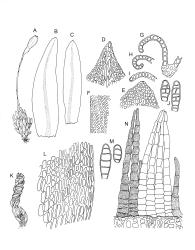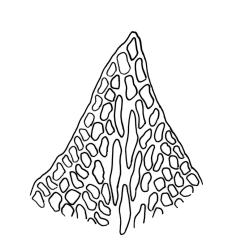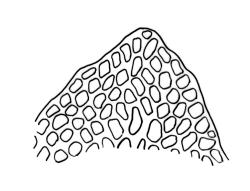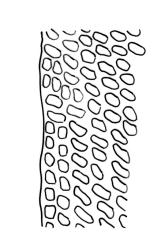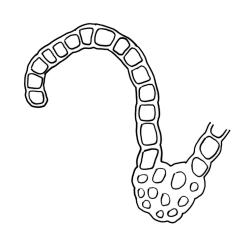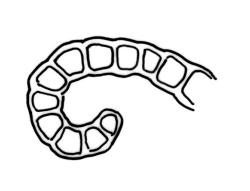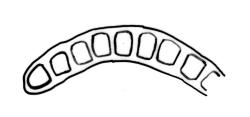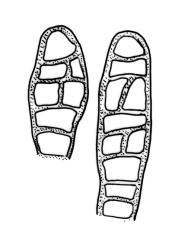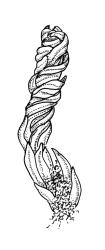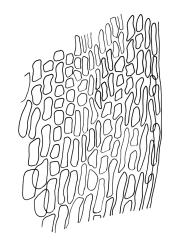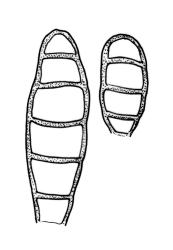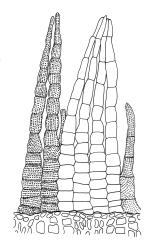- ≡ Codonoblepharon menziesii Schwägr., Sp. Musc. Frond. Suppl. 2(1), 142 (1824)
- = Bryum oamaruense R.Br.bis, Trans. & Proc. New Zealand Inst. 31: 447 (1899)
- = Zygodon menziesii var. angustifolius Malta, Latv. Univ. Raksti 10: 317 (1924)
- ≡ Codonoblepharon menziesii var. angustifolius (Malta) Matcham & O'Shea, J. Bryol. 27: 131 (2005)
Plants to 10 (rarely to 20) mm tall, densely tufted, olive-green to dark green to nearly black above, red-brown to brown below, moderately lustrous. Stems branched (the ♀ plants often by subperichaetial innovation), with a cortex of moderately thick-walled cells surrounding a central core of thin-walled parenchyma and no central strand; rhizoids present on lower stems, brown, finely papillose. Leaves loosely or tightly twisted around the stem or erect-appressed when dry, erect-spreading when moist, ovate lanceolate or elliptic-lanceolate, entire, usually keeled above, with base not decurrent, apex acute, rounded acute, to obtuse, sometimes weakly cuspidate, 1.0–1.6(–2.1) × 0.3–0.5(–0.7) mm; margins narrowly recurved to revolute below or less often plane; upper laminal cells quadrate or rhomboidal, moderately to very thick-walled, smooth, often in oblique rows (and some cells often oblate), sometimes smaller along the margins, 6–12 × 9–12 µm; basal cells rectangular or oblong, thin-walled near costa, becoming more elongate and thicker-walled near the margins, smooth, commonly 20–45(–60) × 12–20 µm (midway to margin), grading into cells of mid lamina. Costa stout, subpercurrent or rarely extending into a cusp, usually red-brown in older leaves, 36–45 μm wide in lower leaf and scarcely tapering, the cells on both surfaces elongate. Gemmae borne in clusters on axillary stalks, clavate or filiform, with 3–7 transverse septa and 0–4 longitudinal septa, 45–150 µm, green or brown. Laminal KOH colour reaction positive yellow.
Dioicous. Perichaetia terminal, perichaetial leaves not differentiated. Perigonia terminal, usually subtended by an innovation (and then appearing lateral), c. 0.6 mm long and nearly globose, orange-brown, gemmiform, with c. 10 antheridia and numerous filiform paraphyses; inner perigonial bracts broadly ovate and strongly concave. Setae (2.5–)4–6 mm, dextrorse, smooth; capsules exserted, narrowly ovoid from a slender neck, narrowed at mouth, becoming ± cylindric when old and dry, straw-coloured or pale yellow-green at maturity, deeply 8-furrowed throughout, 1.5(–2.0) mm; exothecial cells rectangular, in distinct thick- and thin-walled bands; stomata numerous, superficial, restricted to neck; annulus not differentiated; operculum rostrate from a conic base. Peristome double; exostome of 8 pairs of teeth, white or pale yellow, strongly reflexed when dry, transversely striate below and longitudinally striate above on outer surface, c. 350 × 120 μm; endostome lacking a visible membrane, of 8 pale, linear, finely papillose or baculate segments that are ½–¾ the height of the teeth. Calyptra cucullate, smooth, covering c. ½ the capsule. Spores globose, finely papillose, 15–18 µm.
Brotherus 1925, fig. 428e, 429 (a form with almost straight leaves); Malta 1926, figs 94 (as Z. menziesii var. angustifolius), 95, 103 (as Z. menziesii); Lewinsky 1990, figs 100–111, 112–128; Seppelt 2004, fig. 85; Calabrese 2006, figs 1f, 3e, 4–5.
Zygodon menziesii is sometimes confused with Orthotrichum cupulatum, which also commonly grows on calcareous rock. The dry plants of Z. menziesii have a distinctive lustre and usually spirally twisted leaves. In contrast, the dry plants of O. cupulatum are dull and faintly glaucous with nearly straight leaves. Further distinction is provided by the usually distinctly obliquely ranked and smooth upper laminal cells (giving a KOH positive yellow reaction) and the presence of fusiform axillary gemmae in Z. menziesii.
NI: N Auckland, including offshore islands (GB), S Auckland, Gisborne, Hawke’s Bay, Wellington; SI: Nelson, Marlborough, Canterbury (Arthur’s Pass, Hawdon River, Banks Peninsula), Westland, Otago, Southland (Clifton, Riverton Rocks); St; Ch; A; C; M.
Austral. Tasmania*, mainland Australia*. Reported from Chile by Malta (1926). The mainland Australian distribution includes both south-eastern regions and southern W.A. (fide Lewinsky 1990).
Although it is best developed on limestone and marble, Z. menziesii also occurs on other rock types including greywacke, sandstone, granite, and concrete, as well as trunks of a range of both native (including Carpodetus serratus, Corynocarpus laevigatus, Dracophyllum traversii, Fuscospora solandri s.l., Hoheria sexstylosa, Melicytus ramiflorus, and Metrosideros umbellata) and introduced (Populus spp. and Sambucus nigra) tree species. It is tolerant of salt spray. It appears to be a common species on garden walls in Auckland City. Herbarium material from the Hawdon River was collected from "decaying wood" and from the Port Hills (Canterbury L.D.) from "bark of [a] decaying log". Lewinsky (1990) recorded it from both Eucalyptus and introduced trees in Australia. Frequently associated epilithic species include Barbula calycina, Didymodon australasiae, Macromitrium longirostre, M. retusum, Orthotrichum crassifolium, Schistidium apocarpum s.l., and Syntrichia antarctica. Epiphytic associates can include Calyptopogon mnioides, Syntrichia pygmaea, Zygodon hookeri, and Z. intermedius. On the North I. occurring from near sea level to at least 1300 m (Ōhutu Ridge, Hawke’s Bay L.D.) and on the South I. from near sea level to at least 1350 m (Mt. Arthur, Nelson L.D.).
Zygodon menziesii is a morphologically variable species. In its most representative form, the spirally twisted, often dark red-brown and lustrous leaves with stout subpercurrent costae make this species easily recognisable. The firm-walled, smooth, and usually distinctly obliquely ranked upper laminal cells have a distinctive appearance under the compound microscope. Perigonial plants are rarely seen. Given that this species frequently fruits, it is difficult to understand the rarity of male plants. Lewinsky (1990, p. 129) indicated that the endostome here can sometimes have 16 segments, but in my experience such material is very rare (seen only in P. Beveridge s.n., 12 Dec. 2008 from near Balclutha, Otago L.D. (WELT M039453).
A relatively small proportion of populations have longitudinal as well as transversely septate gemmae. This single character difference has been used to define the var. angustifolium Malta. Given the general morphological variability of Z. menziesii in respect of many characters (e.g., stature, the shape of the leaf apex, the degree of reflexion of the leaf margins) and the fact that the presence of the longitudinal gemma walls does not appear to correlate with other character states, the recognition of the variety angustifolium Malta seems unjustified. Those wishing to attempt to segregate this variety should refer to Lewinsky (1990), but it is clear that she also had misgivings about its value.
Lewinsky (1990) illustrated and briefly discussed three growth forms of Z. menziesii. The most common form has brown or dark green leaves firmly twisted around the stems and lanceolate with the margins recurved at least in the lower half. The second has green leaves more loosely twisted around the stems, individually twisted at their apices, longer, often somewhat undulate, and plane at the margins. Lewinsky associated such material with wetter regions. A third form occurs primarily at high elevations in Nelson L.D. and has brown, fairly short, and ± straight leaves that are not twisted around the stems. These differences probably reflect the differences in environmental humidity and insolation. Many intermediate forms between the extremes were noted by Lewinsky, who gave the growth forms no formal taxonomic rank.




